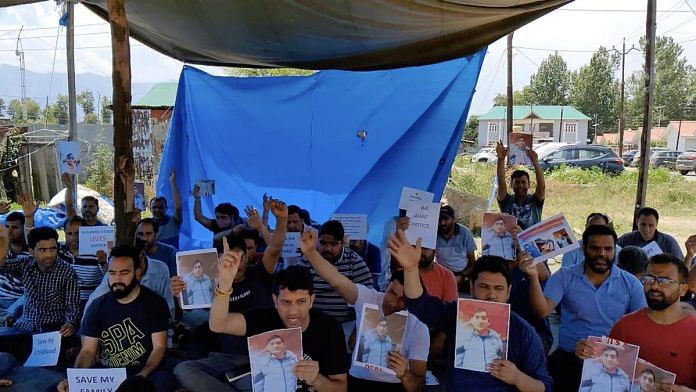The gun fired from the shoulders of Kashmiri Pandits to impress ‘Hindu’ India—revoking of Article 370—has now come back to haunt those it was supposed to have ‘saved’ and rehabilitated. Kashmiri Pandits are once again in the crosshairs of militants when they were supposed to have been freed from their shackles on 5 August 2019. The Narendra Modi government sold the revocation of Article 370 as the mother of all solutions, but now its primary constituency is once again the most vulnerable. This was a foregone conclusion for those who kept an ear to the ground in Kashmir.
Even as tourism booms in the Kashmir Valley bullets find their targets with discriminating frequency as a message to the state and its employees—it is not a done deal yet. Tourists are not the targets, for they bring in money and employment to the locals, but on the other hand, residents of the cleaved state and migrant labourers have been killed selectively. This spate of selective killings in the Kashmir valley is not the work of ‘fringe elements’ but a calibrated campaign of terror and intimidation driven by an agenda that is both political as well as demographic.
Kashmiri terrorists have once again recreated an environment of fear, trauma and a spectre of migration that rewinds back to the early 1990s. This is an extraordinary triumph for terrorism as the sheer number of active militants is a pale shadow of that dark and dreary decade. Visitors, observers and those who lived in Kashmir Valley in the 1990s recollect a security situation that was grim to the core. While at one point the total active militants in the 1990s topped 3,000 it is now closer to 200, yet they have managed to instil fear disproportionate to the numbers involved and investments made.
Also Read: Modi govt’s rehabilitation of Kashmiri Pandits fell flat. They’re strangers in their own land
Logistics of militancy in Kashmir
In all militancy, there’s an indecipherable ratio of investments to returns. Just as a soldier costs the state from the date of his joining, so does a militant to his terrorist group from induction, and beyond his death too. So Left-wing Naxal militants would have a ratio vastly different from politico-messianic jihadis of the Kashmir Valley. And militants in Assam or Nagaland would have an altogether different ratio. Therefore each work according to their terrain, targets, techniques involved and resources available, including manpower, finances and hardware available. No militancy can survive without all three of these essentials, notwithstanding the best operational terrain, or easy targets and techniques. The prevailing environment also has an influence on militant options.
With numbers less than a tenth of their peak, money squeezed and changing global and regional environment, the Kashmiri militants have been compelled to find alternative options to convey their message—it is not a done deal yet. A largely successful counter-infiltration policy on the Line of Control, ceasefire with Pakistan sustaining, and global action against terror financing has resulted in a squeeze on militant funds. Even the messianic forces need money to attract cadres. Those funds only came into focus once the full scale of the 11 September 2001 attacks became apparent. Since then, the Financial Action Task Force included terror finance in its purview and has been slowly tightening the screws. Pakistan, as a result, has continued to hover on its grey list, sitting beside the United Arab Emirates, which has a leadership on ‘hugging terms’ with New Delhi.
Over the years, the efforts have borne fruit. Funds for militants have dwindled drastically. And with improvements in financial investigations, the grip was tightening and became deadly with the enhanced capabilities of the Jammu & Kashmir Police.
Also Read: Only dialogue, not Army, can stop targeting of Kashmiri Pandits. But make J&K a state first
Stage for another tragedy
Militants and their masterminds resorted to measures that were, for them, cost-effective as well as easy to undertake. They chose the easiest targets who would also provide them with disproportionately greater commotion.
Given the deliberate policy of humiliating the Kashmir Valley, it was easy for the militants to find volunteers for such jobs. It is likely that some of these assassins may never fire another weapon again, and simply meld into society. In the cat and mouse game to find the ‘perpetrators’, the hunter is unlikely to always succeed. It sets the stage for another tragedy to unfold.
A desperate Modi government is now moving some of the Kashmiri Pandit and other non-Muslim employees into ‘safe’ areas only because it doesn’t want to be accused of abetting another round of internal displacement. This will involve the deployment of additional troops on security duties for these state government employees.
The entire affair evokes memories of an apartheid-era Bantustan, a territory which was created for the black inhabitants of South and South West Africa, morally unacceptable and alien to Indian concepts of reconciliation. Those driven out of their villages in India are only able to return once the rapprochement is mutually acceptable. Kashmiri Pandits can only be safe in their homes once their villages are at peace.
Manvendra Singh is a Congress leader, Editor-in-Chief of Defence & Security Alert and Chairman, Soldier Welfare Advisory Committee, Rajasthan. He tweets @ManvendraJasol. Views are personal
(Edited by Srinjoy Dey)



